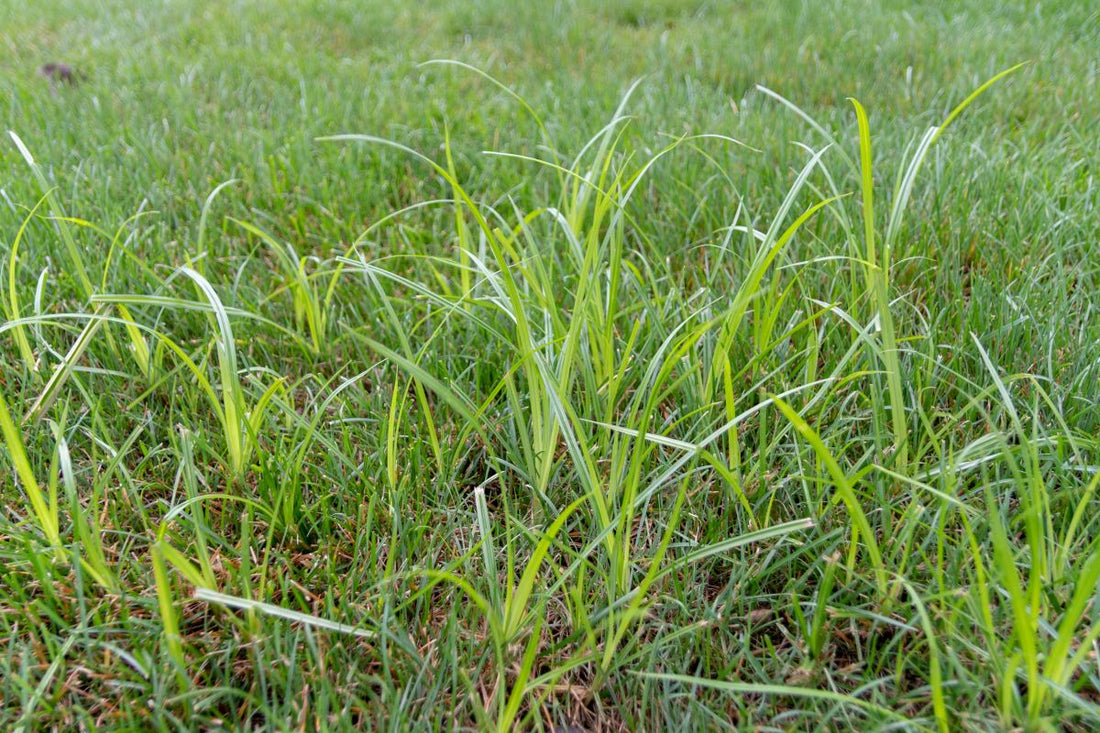Nutsedge, frequently called nutgrass, is a stubborn, invasive weed that challenges homeowners and lawn enthusiasts alike.
Unlike common grassy weeds, nutsedge is actually a sedge, distinguished by its triangular stems and swift growth, especially in moist environments.
While many rely on post-emergent herbicides to clear visible nutsedge, integrating pre-emergent tactics can be crucial in preventing its spread from the start.
This article explores the nature of nutsedge, assesses the best pre-emergent for nutsedge, and offers practical advice for its control, so that you can enjoy a perfect lawn year-round.
What this article covers:
- What Is Nutsedge (aka Nutgrass) and Why Is It So Persistent?
- Can Pre-Emergent Herbicides Stop Nutsedge?
- Best Pre-Emergent Options with Nutsedge Suppression Potential
- When to Apply Pre-Emergent for Maximum Nutsedge Control
- How to Combine Pre- and Post-Emergent in a Nutsedge Plan
- Mistakes to Avoid When Trying to Control Nutsedge
What Is Nutsedge (aka Nutgrass) and Why Is It So Persistent?
Nutsedge, often called nutgrass, includes several species, most commonly yellow nutsedge (Cyperus esculentus) and purple nutsedge (Cyperus rotundus).
These perennial sedges thrive in warm, moist environments and are known for spreading quickly through both visible growth and underground structures.
What makes nutsedge especially persistent is its ability to reproduce in multiple ways. It forms underground tubers (or nutlets) that store energy, allowing the plant to regenerate even after you remove the top growth.
It also spreads via rhizomes, horizontal underground stems that enable it to colonize new areas. While less common, nutsedge can even reproduce through seeds.
This trio of reproductive strategies makes it incredibly difficult to eliminate once it's taken hold in your lawn, flower beds, or rock beds.

Can Pre-Emergent Herbicides Stop Nutsedge?
A pre-emergent herbicide works by creating a chemical barrier in the soil, preventing weed seeds from germinating and growing.
However, their effectiveness against nutsedge is limited due to the plant's primary mode of reproduction, which involves tubers and rhizomes rather than seeds.
Consequently, while pre-emergents can suppress seed germination, they do little to hinder the sprouting of established tubers.
Relying solely on pre-emergent herbicides for nutsedge control is insufficient. An integrated approach, combining both pre- and post-emergent strategies, is essential for effective management.
Best Pre-Emergent Options with Nutsedge Suppression Potential
While no pre-emergent herbicide offers complete control over nutsedge, certain products can suppress its growth, especially when combined with other control methods.
Here are some options:
- Pennant Magnum (Active Ingredient: Metolachlor): Primarily used for pre-emergent control of yellow nutsedge and annual grasses. It inhibits cell division in emerging shoots, reducing nutsedge emergence from seeds. However, it has a limited effect on established tubers.
- Tower Herbicide (Active Ingredient: Dimethenamid-P): Offers pre-emergent suppression of yellow nutsedge and certain broadleaf weeds. Like Pennant Magnum, its efficacy is limited to seed germination and does not affect tubers.
- Snapshot 2.5 TG: While primarily labeled for broadleaf and grassy weeds, it can offer some suppression of nutsedge in ornamental beds. It's considered one of the best pre-emergent options for flower beds.
It's crucial to note that these products should be part of a broader nutsedge management plan. Even the best weed pre-emergent will have limited effects against nutsedge if not combined with a more nutsedge-focused elimination strategy.

When to Apply Pre-Emergent for Maximum Nutsedge Control
Timing is crucial when applying pre-emergent herbicides for nut sedge suppression.
For optimal results:
- Early Spring Application: Apply pre-emergents when soil temperatures consistently reach 50–55°F (10–13°C). This typically occurs in early to mid-spring, depending on your region. This timing aims to prevent the germination of nutsedge seeds.
- Late Summer Application: A second application in late summer can help suppress late-season germination.
However, since nutsedge primarily propagates through tubers, these applications should be complemented with post-emergent treatments targeting existing plants.
How to Combine Pre- and Post-Emergent in a Nutsedge Plan
Controlling nutsedge can feel like an uphill battle because it spreads underground and doesn't rely heavily on seeds—a tricky foe for gardeners. That's why using a blend of strategies really is your best bet at complete control.
Begin with a pre-emergent treatment early in spring to curb new nutsedge from sprouting, though it won't halt growth from existing tubers. It's just the first step.
Then, when it's visibly growing, a selective post-emergent herbicide like halosulfuron-methyl or sulfentrazone can do wonders, targeting those stubborn plants without harming your lawn.
Between treatments, focus on keeping your turf healthy and dense: mow regularly, avoid overwatering, and fertilize appropriately, especially if you're dealing with cool-season grasses like fescue.
Keep a close watch on stubborn spots. If nutsedge pops back, a second round of post-emergent or another pre-emergent later in the season might be needed.
Managing nutsedge isn't quick or easy, but with persistence and a flexible plan, you're giving yourself a real shot at long-term control.

Mistakes to Avoid When Trying to Control Nutsedge
Even seasoned DIYers can make missteps when battling nutsedge. Avoid these common errors to give your lawn a fighting chance:
- Don't rely solely on pre-emergents: Pre-emergents like Pennant Magnum may help reduce germination from seed, but they won't stop established plants growing from tubers. If you skip post-emergents like halosulfuron or sulfentrazone, you're leaving most of the problem untouched.
- Delaying treatment: Nutsedge grows fast and builds underground strength quickly. Once it's mature, even post-emergent control becomes harder. Spot and spray young plants early in the growing season, before they spread rhizomes or form nutlets.
- Using the wrong herbicide: Broad-spectrum or non-selective herbicides might kill nutsedge, but they can also take out your fescue or ornamental beds in the process. Always match your product to your turf type and read labels carefully.
- Inadequate lawn maintenance: Weeds thrive where grass struggles. Overwatering, compacted soil, and scalping all give nutsedge the upper hand. Keep your lawn dense and competitive through proper mowing height, balanced fertilizer, and consistent watering.
Conclusion
Controlling nutsedge requires a multifaceted approach that combines timely pre-emergent applications, effective post-emergent treatments, and sound lawn care practices.
While pre-emergents alone cannot eradicate nutsedge due to its tuber-based reproduction, they play a role in suppressing seed germination and should be part of an integrated management plan.
By understanding the biology of nutsedge and implementing a comprehensive control strategy, you can reclaim your lawn and prevent future infestations.
If you're unsure about the next steps, get in touch with Lawn Synergy. From product recommendations to location-specific advice, we're here to help you achieve your dream lawn!
Ready to learn more? Check out these articles:
-
Best Pre-Emergent for Flower Beds
-
Best Pre-Emergent for Fescue Grass
-
Best Pre-Emergent for Rock Beds
- When to Apply Pre Emergent in NC
- When to Apply Pre Emergent in Georgia
- When to Apply Pre Emergent in South Carolina
- When to Apply Pre Emergent in Florida
- When to Apply Pre Emergent in Tennessee
- Best Pre-Emergent for North Texas
- Best Pre-Emergent for Poa Annua
- Best Pre-Emergent for Arizona
- The Best Pre-Emergent for Zoysia
- Best Pre-Emergent for Bermuda Grass in Texas
- Soil Temp for Pre-Emergent
- Pre-Emergent Before Rain

